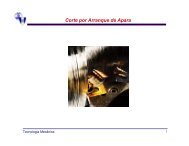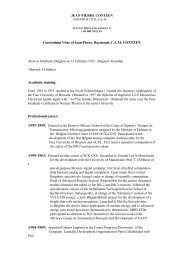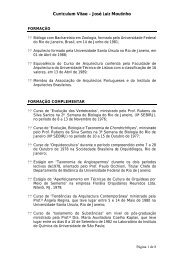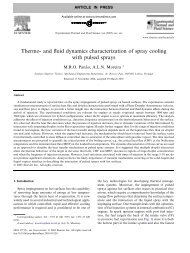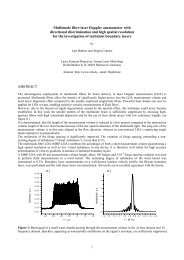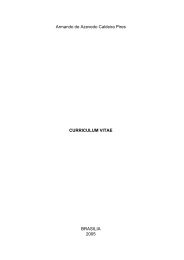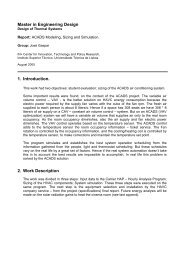download
download
download
You also want an ePaper? Increase the reach of your titles
YUMPU automatically turns print PDFs into web optimized ePapers that Google loves.
ε M/ U 1 3<br />
1E-4<br />
Larue Re M<br />
= 6000<br />
" Re M<br />
= 10000<br />
" Re M<br />
= 14000<br />
" Re M<br />
= 12000<br />
Wyatt(1955) Re M<br />
= 11000<br />
Van Atta & Chen (1969) Re M<br />
= 25600<br />
Comte-Bellot & Corsin (1966) Re M<br />
= 34000<br />
Sreenivasan et al. (1980) Re M<br />
= 7400<br />
Uberoi (1963) Re M<br />
= 10000<br />
Uberoi & Wallis (1967) Re M<br />
=29000<br />
Sirivat & Warhaft (1983) Re M<br />
=8750<br />
present data Re M<br />
=5150<br />
1E-5<br />
20 25 30 35 40 45 50 55 60<br />
x 1<br />
/M<br />
Figure 7 Comparison between the values assumed by the dimensionless dissipation<br />
previous works.<br />
ε M/ U 1<br />
3<br />
in the present and in<br />
The comparison between the values of the dissipation calculated from the decay of kinetic energy and from the<br />
direct estimation of the gradients have been illustrated in Figure 1. According to the isotropic relation (4), the<br />
contribution to dissipation due to the spatial gradient ( u ∂ ) 2<br />
gradients ( ∂ u ∂ ) 2<br />
and ( u ∂ ) 2<br />
1<br />
x 3<br />
∂ .<br />
3<br />
x 1<br />
5. Flow in the wake of a cylinder<br />
∂ in (6) have been substituted with the spatial<br />
3<br />
x 2<br />
X 1 /d<br />
X 1<br />
X 3<br />
The measurements were carried out across the wake of the<br />
cylinder along a line parallel to the X 3 direction located in the<br />
centre of the test section and at a distance from the cylinder of<br />
X 1 /d equal to 10 (Figure 8). The points of measurements are<br />
X 3 /d: -0.2, -0.1, 0, 0.1, 0.2, 0.3, 0.4, 0.5, 0.8, 1.2, 1.6, 2.<br />
The Reynolds number Re d is 7200 and the diameter d of the<br />
cylinder is 7.2 mm.<br />
Line of<br />
measurement<br />
X 2<br />
X 3<br />
Figure 8 Diagram showing the locations where<br />
the measurements were taken<br />
The method used to determine the gradients is the same as<br />
described earlier for the grid turbulence flow. In this case it is<br />
necessary to separate the turbulence from the periodic motions<br />
due to the presence of mean flow variations due to vortex<br />
shedding. As for the grid turbulence flow, the two data series,<br />
one from each of the two probes, have been scanned to find<br />
the particles that satisfy the condition of equation (10).<br />
The periodic motions have been identified by low pass<br />
filtering the spectra of the two data series.<br />
In Figure 9 the total velocities of the particles in coincidence<br />
and the velocities due to the periodicity of the flow (the low<br />
pass filtered velocities) are shown.<br />
9




